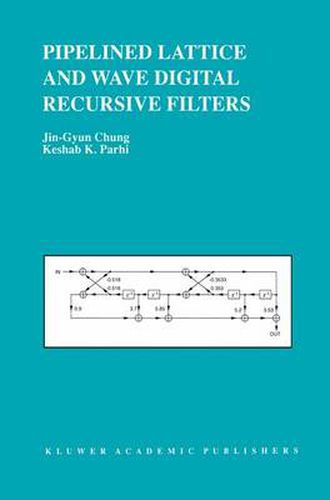Readings Newsletter
Become a Readings Member to make your shopping experience even easier.
Sign in or sign up for free!
You’re not far away from qualifying for FREE standard shipping within Australia
You’ve qualified for FREE standard shipping within Australia
The cart is loading…






This title is printed to order. This book may have been self-published. If so, we cannot guarantee the quality of the content. In the main most books will have gone through the editing process however some may not. We therefore suggest that you be aware of this before ordering this book. If in doubt check either the author or publisher’s details as we are unable to accept any returns unless they are faulty. Please contact us if you have any questions.
This text uses look-ahead transformation and constrained filter design approaches. It is shown that pipelining often reduces the roundoff noise in a digital filter. The pipelined recursive lattice and wave digital filters presented are well suited where increasing speed and reducing area or power or roundoff noise are important. Examples are wireless and cellular codec applications, where low power consumption is important, and radar and video applications, where higher speed is important. The book presents pipelining of direct-form recursive digital filters and demonstrates the usefulness of these topologies in high-speed and low-power applications. It then discusses fundamentals of scaling in the design of lattice and wave digital filters. Approaches to designing four different types of lattice digital filters are discussed, including basic, one-multiplier, normalized, and scaled normalized structures. The roundoff noise in these lattice filters is also studied. The book then presents approaches to the design of pipelined lattice digital filters for the same four types of structures, followed by pipelining of orthogonal double-rotation digital filters, which eliminate limit cycle problems. A discussion of pipelining of lattice wave digital filters follows, showing how linear phase, narrow-band, sharp-transition recursive filters can be implemented using this structure. This example is motivated by a difficult filter design problem in a wireless codec application. Finally, pipelining of ladder wave digital filters is discussed.
$9.00 standard shipping within Australia
FREE standard shipping within Australia for orders over $100.00
Express & International shipping calculated at checkout
This title is printed to order. This book may have been self-published. If so, we cannot guarantee the quality of the content. In the main most books will have gone through the editing process however some may not. We therefore suggest that you be aware of this before ordering this book. If in doubt check either the author or publisher’s details as we are unable to accept any returns unless they are faulty. Please contact us if you have any questions.
This text uses look-ahead transformation and constrained filter design approaches. It is shown that pipelining often reduces the roundoff noise in a digital filter. The pipelined recursive lattice and wave digital filters presented are well suited where increasing speed and reducing area or power or roundoff noise are important. Examples are wireless and cellular codec applications, where low power consumption is important, and radar and video applications, where higher speed is important. The book presents pipelining of direct-form recursive digital filters and demonstrates the usefulness of these topologies in high-speed and low-power applications. It then discusses fundamentals of scaling in the design of lattice and wave digital filters. Approaches to designing four different types of lattice digital filters are discussed, including basic, one-multiplier, normalized, and scaled normalized structures. The roundoff noise in these lattice filters is also studied. The book then presents approaches to the design of pipelined lattice digital filters for the same four types of structures, followed by pipelining of orthogonal double-rotation digital filters, which eliminate limit cycle problems. A discussion of pipelining of lattice wave digital filters follows, showing how linear phase, narrow-band, sharp-transition recursive filters can be implemented using this structure. This example is motivated by a difficult filter design problem in a wireless codec application. Finally, pipelining of ladder wave digital filters is discussed.